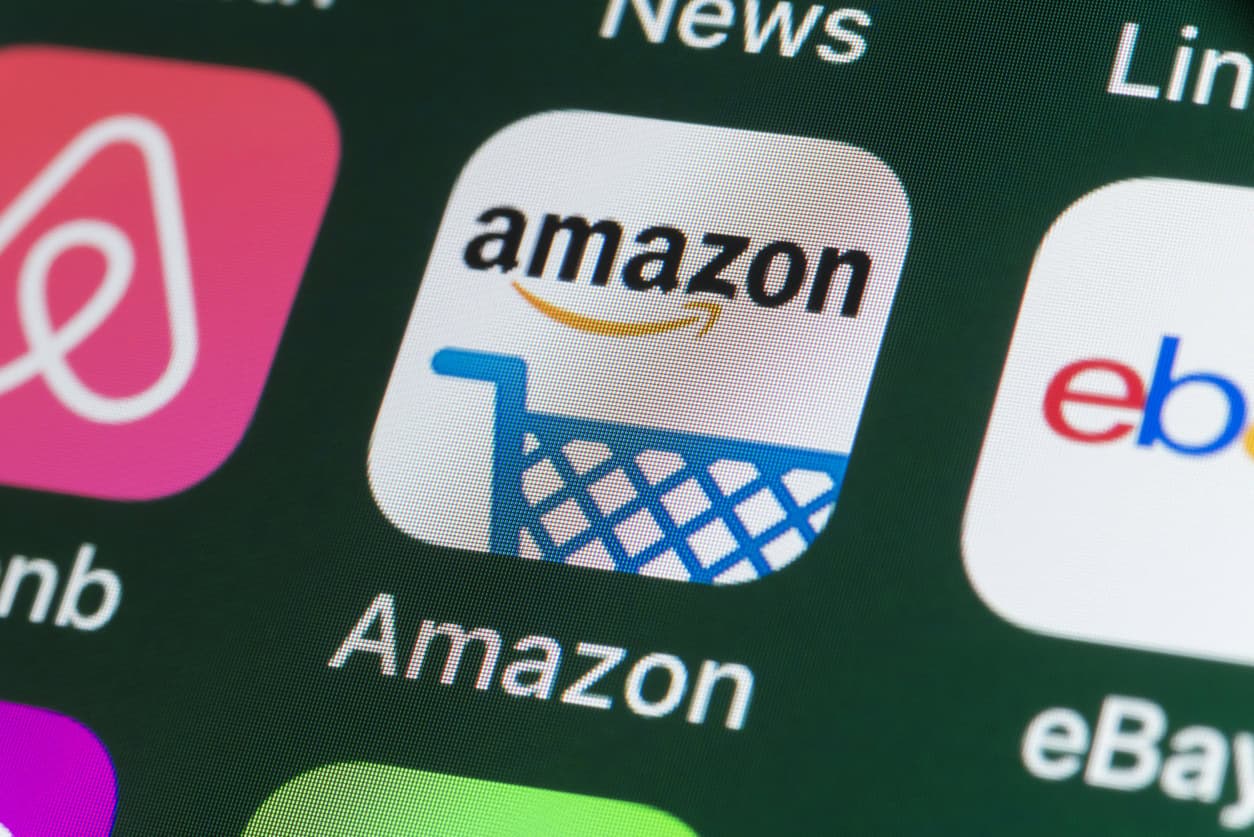
iStock.com/stockcam
May 28, 2024
Should Brands Still Have Qualms About Selling on Amazon?
Rothy’s, the eco-conscious footwear brand, and skincare brand Kiehl’s both recently became the latest in an increasing mass of brands opening up storefronts on Amazon.com.
Both brands cited the benefits of reaching a wider audience.
“Like Amazon, we are obsessed with our customers,” Jenny Ming, CEO at Rothy’s, said in a statement. “We are constantly looking for new ways to improve our shopping experience and be where our customer wants us to be. Now they can now shop Rothy’s in Amazon’s store as they build their basket — delivered to their doorstep with the speed and efficiency that Amazon is known for.”
In a press release for Kiehl’s Since 1851, general manager John Reed said, “Launching in the Amazon Premium Beauty store marks a new chapter in the Kiehl’s journey of over 170 years of skincare and innovation. Inspired by our heritage as a neighborhood apothecary brand, this collaboration allows us to continue our legacy while providing high-performance skincare solutions at even greater scale.”
More brands have started launching landing pages tied to the Amazon Fashion or Amazon Premium Beauty homepages in recent years after being reluctant to sell on the platform due to concerns over brand perception, lack of control over presentation and customer service, and the need to provide Amazon access to their brand’s customer data.
Among other newer sellers, Estée Lauder in March started selling its first brand, Clinique, on Amazon with a promise to add more. L’Oréal, the parent of Kiehl’s, started selling Lancôme directly on Amazon last October.
Coach began trialing sales of a limited range on Amazon last September. Joanne Crevoiserat, CEO of Coach’s parent company Tapestry, told analysts last year, “The platform provides broad consumer reach and plays a vital role in the customer’s discovery and purchase journey, specifically for younger cohorts.”
Victoria’s Secret and the Gap banner over the last two years landed among the few specialty chains to start selling directly on Amazon. Mattel opened an American Girl storefront on Amazon in December 2022, and Rent the Runway started selling secondhand luxury on Amazon in January 2023.
Amazon now has dedicated storefronts for most brands that sell in traditional department stores, including Polo Ralph Lauren, Hugo Boss, Michael Kors, Levi’s, adidas, and The North Face.
Jungle Scout found that the majority (51%) of consumers start their online searches for products on Amazon as of Q3 2023, followed by a search engine (39%), Walmart.com (34%), and YouTube (23%).
Still, many vendors are holding out, including Birkenstock in 2016 and Nike in 2019 moving to stop selling directly through Amazon. Other more accessible labels not selling directly on Amazon include Patagonia, Vans, Vuori, Free People, and Hoka One One, while the majority of luxury brands, including Gucci, Prada, and Tory Burch, aren’t yet selling directly on the platform.
Simeon Siegel, an analyst at BMO Capital Markets, told Women’s Wear Daily that he expects many more brands will open up Amazon storefronts after recognizing the reach-benefit of having wholesale partners and the shortcomings of direct-to-consumer approaches. However, he also cited the risks of selling to discount-emphasized sites such as Amazon. He said, “Companies chase revenues that are bad for their business that will cost them more in the future than they will earn today. But the problem is a dollar today looks very attractive, even if it costs two tomorrow.”
Discussion Questions
Why has the stigma of selling directly on Amazon apparently evaporated for many brands in recent years?
What advice would you have for premium brands around whether or not to sell directly on Amazon?
Poll
BrainTrust
Jenn McMillen
Chief Accelerant at Incendio & Forbes Contributing Writer
Gene Detroyer
Professor, International Business, Guizhou University of Finance & Economics and University of Sanya, China.
Brett Wickard
CEO, FieldStack
Recent Discussions







Amazon offers brands something very compelling: access to a huge audience. That is why many are tempted to sell via the online giant – especially so brands like Gap, Victoria’s Secret and Peloton who have their own problems in selling directly! The issue is that brands can become too dependent on Amazon, rack up various charges, and there is always the (largely unfounded) fear that Amazon can use data to develop its own products and initiatives. So, ultimately it’s a balancing act for brands. Some will determine that they want to exert control over their distribution and brand image, others will take the extra revenue and customer penetration Amazon can generate for them. It’s really the same sort of debate as wholesale versus direct to consumer and the answer depends on the maturity and position of the brand. One thing I would say, however, is that Amazon is not viewed by consumers as a cheap and cheerful site: customers are very happy to explore and buy premium brands on there.
In our most recent consumer survey, we asked where participants go *first* across each category. For beauty, apparel & accessories, electronics, and office supplies, consumers said they went to Amazon first. Thus, for many brands, it’s imperative to be on Amazon- especially in the trend spaces. I do think for a small group of brands, though, this move can erode the luxury status, not because consumers associate Amazon with being less expensive, but because the of the ubiquity.
Selling on Amazon comes down to reaching a broader audience and accepting the leverage that creates by using Amazon versus going at it without Amazon but retaining more control over the situation. If you are an unknown brand, Amazon’s scale could be tempting, and perhaps necessary, to make a go of it.
Brands should continue to be very concerned about Amazon. I can no longer, for example, search for a specific tool by brand and have that tool presented within the first two or three pages of results. Instead, those pages are filled with unrelated tools from unrelated brands — especially those brands invented solely for Amazon.
This is not an environment where the brand builds value by selling through Amazon. The only value they get are whatever margin dollars come from an individual sales. By contrast, selling in a retail store customers build awareness of the brand in that store so each sale has possible future value — and customers often add other products from a brand.
There’s no mystery here: you reach a wider potential market, and give up some control over your product in exchange; it’s little different in concept than a manufacturer allowing its product to be sold in stores (tho of course the details vary). But that having been said, it’s important – crucial? – to remember that “a wider market” isn’t necessarily a goal for upscale brands; au contraire it’s often what they’re trying to avoid. So while my advice for most products tends toward “go”, for premium brands it tends toward “no go” …or at least “think about it a bit more.”
With more than 25% of all consumer goods sold via e-commerce, and 67% of that amount purchasing on Amazon, it is unwise for almost any consumer brand to avoid Amazon.
But what you do need to avoid are typical mistakes that companies make when doing business with Amazon.
For instance, you must avoid having to compete with third party sellers on you very own brand. Third parties are also problem for controlling price point management, brand messaging and imaging,
It’s not good enough to keep third parties out strictly by not selling to them. What you need to know is who of your current customers are selling your products to third parties. You need to be diligent in not selling to customers that will in turn sell your products to third parties.
As one example, there are hundreds of “Mom and Pop” corner stores buying loads of product, way beyond reason, from wholesalers. These tiny businesses often become large third party sellers on Amazon. In that regard, you need to carefully manage your wholesaler business.
Amazon is good business until you lose control of your brand. Db
I don’t believe the stigma of selling on Amazon has evaporated, but it has subsided. The more top brands that choose to sell their goods on Amazon, the more brands it will attract. Lot’s of brands are still staying away, and that’s their prerogative, but it’s hard to deny the reach and exposure of Amazon which is very compelling. Brands that choose to sell on Amazon should remain vigilant about how their products are advertised and sold and be prepared to take action if they feel that the Amazon relationship is tarnishing their brand in any way. For these brands I say, Caveat Venditor…let the seller beware.
Rothy’s is a middle America brand, and middle America uses Amazon as its style arbiter these days. If you want to reach a bigger audience, you need to be on Amazon, for better or worse. Plus, Amazon Prime usually beats the pants off the standard delivery timelines of the brands themselves.
As mentioned in the article, the concerns brands have had in the past include brand perception, lack of control, and providing Amazon access to customer data. These all have some validity, so it comes down to the balance of what can be controlled, the desired brand image, and the opportunity for additional consumers and revenue. Younger shoppers especially focus on Amazon, while others may look to Amazon for information gathering before going to specific brand sites. Premium luxury brands will likely continue to avoid Amazon if possible, while many other brands will look to offer some of their assortment on Amazon for exposure and revenue, as long as they can appropriately manage pricing and margins.
“Amazon Has Over 310 Million Active Users Globally. With over 80% of the users from the United States, there are more than 310 million active users of Amazon globally. Around 230 million Amazon customers are from the United States. In addition, Amazon received over 2.72 billion unique monthly visitors in 2023.”
How can that be ignored by a company trying to reach potential customers?
Selling on Amazon sounds like it would be a result of a series of if/then questions. How distinctive is your brand? Is it a go-to for your product category? If yes, then you may not need Amazon. If no, then you probably need the traffic. But the traffic means competition, lots of it. Is your brand positioned well to compete on Amazon? If not, then how will you fix that? Are you prepared to give Amazon your sales data and educate them on your product category? Amazon is great if not completely necessary for many brands and product categories. But if I was a premium brand, I would be very careful about diluting any level of distinction or differentiation that I may enjoy. And my selling data would be the last thing I would want to give up.
Yes, selling on Amazon means competition. But if a brand doesn’t sell on Amazon, it may never get a chance to compete.
Coffee was bad for you then good for you then bad for you; coffee is to us like Amazon is to brands – Good. Bad. Good again?
I’m not sure that the stigma has disappeared as much as “the sales” have disappeared and that disappearance is accompanied with the appearance of top-line growth pressure. I think brands are trying to find ways to sell more and it’s difficult to ignore the temptation that is Amazon. But like its namesake, it’s a jungle in there and I think brands should have a well-defined plan for entering that jungle or risk getting lost (or worse, never coming out alive).
In 2022, Statista reported that “pricing” was the number 3 reason people shopped on Amazon; roughly three years earlier it had reported that it was number 1. I believe that Amazon can erode the prestige and premium of some brands so they should exercise great care or stay out. After all, does the image conscious, premium-paying buyer really want to pay a premium if their image defining product can be purchased on Amazon? Ultimately, I agree with Melissa that some (probably most) brands should be in Amazon and some should probably remain on their own. However, as always, brands should have well defined strategic plans for Amazon (for all their distribution channels).
Amazon is an essential sales and distribution platform, brands just need to know/understand how to use it properly to their advantage. I particularly like the Coach example of using it essentially for market feedback. These “power struggles” are never going to go away when it comes to Brands Vs. Retailers, they will ebb and flow depending on each relationship.
Maybe you trail a new product. Perhaps you use it as a channel to “dump” not so popular offerings. Just do not sell on it and watch your margins suffer.
Brands make the same asymmetric errors when selling on Amazon that they make elsewhere: Too often erring on the side of short term gain over longer term brand value. Agreed that many brands either need to be on Amazon – or transitionally on Amazon – but they need to value and understand their brand’s customer journey – and make sure to keep an eye on the long term.
Amazon is the #1 apparel retailer in the U.S. Amazon is the #1 beauty destination. Brands in these categories (and others) need a presence where their target audience already shops.
Selling on Amazon (FBA) is a great example of embracing the best way to promote, price, and distribute your goods to a larger consumer market for a minimal price. The true question here is why wouldn’t a CPG not want to embrace FBA as a mainstay of their corporate sales, promotion, and logistics efforts?